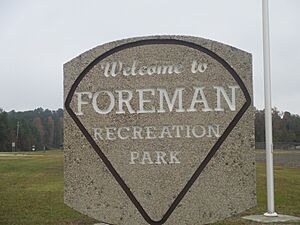Foreman, Arkansas facts for kids
Quick facts for kids
Foreman, Arkansas
|
|
|---|---|

Foreman City Hall
|
|

Location of Foreman in Little River County, Arkansas.
|
|
| Country | United States |
| State | Arkansas |
| County | Little River |
| Area | |
| • Total | 1.99 sq mi (5.15 km2) |
| • Land | 1.98 sq mi (5.12 km2) |
| • Water | 0.01 sq mi (0.03 km2) |
| Elevation | 404 ft (123 m) |
| Population
(2020)
|
|
| • Total | 977 |
| • Density | 494.18/sq mi (190.85/km2) |
| Time zone | UTC-6 (Central (CST)) |
| • Summer (DST) | UTC-5 (CDT) |
| ZIP code |
71836
|
| Area code(s) | 870 |
| FIPS code | 05-24250 |
| GNIS feature ID | 2403631 |
Foreman is a small city located in Little River County, Arkansas, in the United States. In 2010, about 1,011 people lived there.
Contents
Where is Foreman?
Foreman is in the southwest corner of Arkansas. It is close to the Little River, which flows into the Red River. This area has rich and fertile land.
The city covers about 2 square miles (5.1 square kilometers). Most of this area is land, with a very small part being water.
How Many People Live in Foreman?
In 2020, there were 977 people living in Foreman. There were 552 households and 305 families.
Here's a quick look at the population changes over the years:
- 1970: 1,173 people
- 1980: 1,377 people
- 1990: 1,267 people
- 2000: 1,125 people
- 2010: 1,011 people
- 2020: 977 people
A Look Back: Foreman's History
Early Days of Little River County
Little River County was created in 1867. This made it easier for people to reach their local government. The county got its name from the nearby Little River.
The land around Foreman is known for its limestone. This rock is important for making cement. Because of this, several cement companies have operated here. Today, Ash Grove Cement Company is a major producer of cement in the area.
Settlers and Changes
Long ago, the Caddo and Quapaw Native American tribes lived in this area. Settlers started arriving in the early 1800s. Towns like Laynesport and Richmond began to grow.
During the American Civil War, people in the South faced many difficulties. They grew less cotton and focused on other goods for the war. Many families lost their homes and money.
After the county was officially formed, the first courthouse was near a place now called Alleene. Later, the county records moved to Rocky Comfort, which is now Foreman. Richmond also had a courthouse, and its citizens worked hard to keep the county seat there.
Moving the County Seat
In 1902, the county seat moved from Richmond to Foreman. But the competition wasn't over! Foreman and Ashdown then competed to be the county seat. In 1906, Ashdown won the election. All the county records were moved to Ashdown, and a new courthouse was built there in 1907.
Tough Times and New Industries
The Great Depression started in 1929 and affected everyone, including people in Little River County. Farms struggled, and many people lost their jobs. Farmers had to sell their land.
For a long time, farming was the main way people made money. Cotton was the biggest crop. But soon, the timber industry (cutting down trees for wood) became very important. Many small towns grew up near sawmills or cotton gins.
Railroads also changed the county. The first railroad arrived in 1889. Trains made it easier to transport goods and helped the county grow. Soon, electricity and telephone services became available in some parts of the county.
Modern Era and Growth
After World War II, factories started to change the economy. The creation of Millwood Lake in 1965 was a big deal. It provided a lot of water, which was important for new industries.
A large paper mill, now owned by Domtar Industries, was built in Ashdown in 1968. It is a major employer today. The Ash Grove Cement Company in Foreman also brings a lot of money to the county. It was built in 1956 and rebuilt in 2010.
With these new industries, the county grew. New medical facilities and schools were built. A modern bridge was built over the Red River in 1980. New highways also made it easier to travel to nearby cities like Texarkana.
Education in Foreman
Students in Foreman attend public schools run by the Foreman School District.
- Foreman High School serves students in grades 7 through 12.
- Foreman Elementary School teaches students from kindergarten through sixth grade.
Famous People from Foreman
- Marion H. Crank: A former state representative and Speaker of the Arkansas House of Representatives.
- Jimmy "Preacher" Ellis: A blues singer and guitarist.
- Charles Jackson French: A hero from World War II.
- James T. Horn: A country music singer.
- Tracy Lawrence: A country music singer.
- Marshall Wright: A Democratic member of the Arkansas House of Representatives. He graduated from Foreman High School.
Images for kids
See also
 In Spanish: Foreman (Arkansas) para niños
In Spanish: Foreman (Arkansas) para niños



